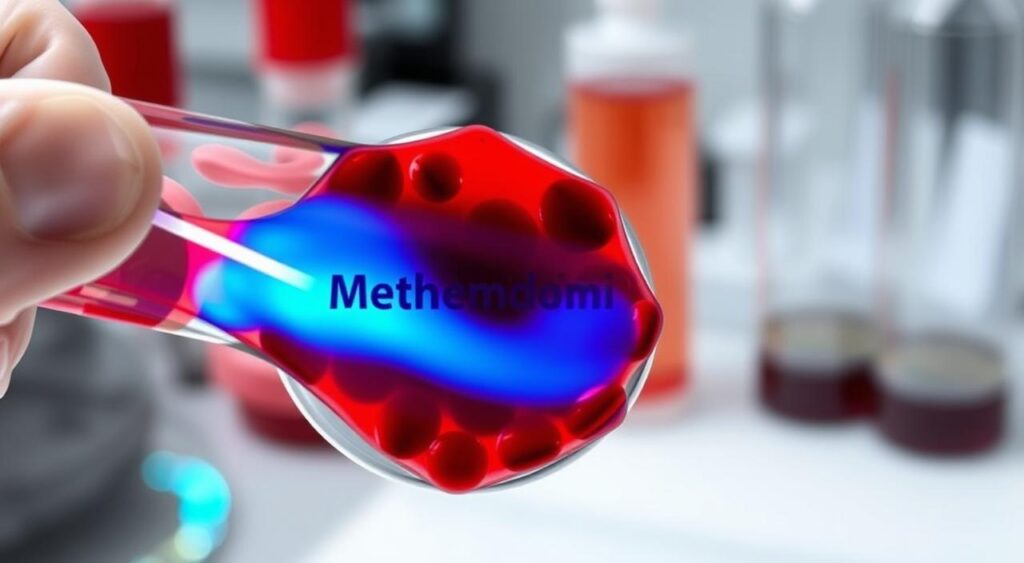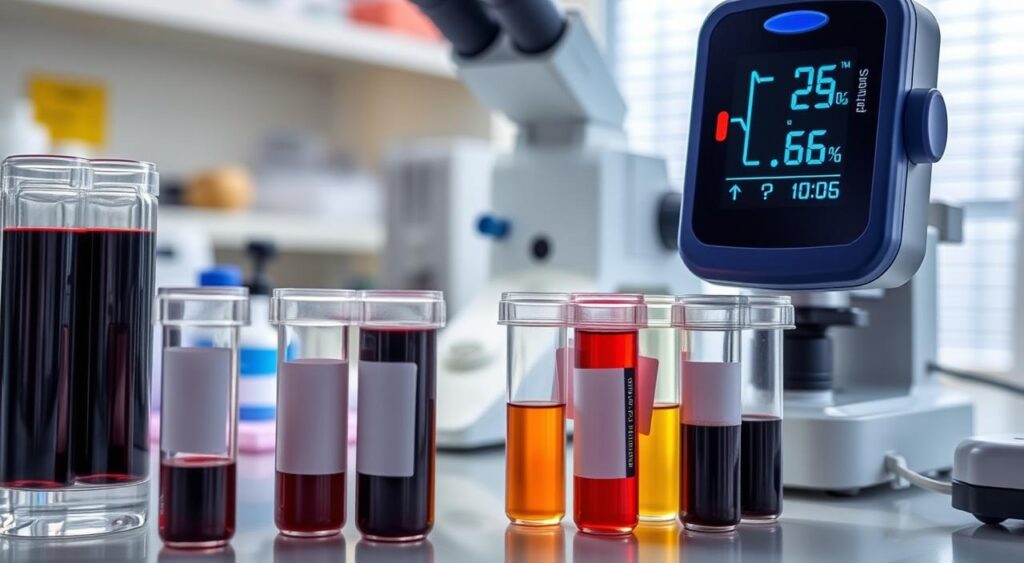Methemoglobinemia: It’s a rare blood disorder with high methemoglobin levels. This condition makes it hard for blood to carry oxygen to the body’s tissues and organs. Knowing about methemoglobin levels is key to diagnosing and treating Methemoglobinemia.

Many things can cause Methemoglobinemia, like genetic problems, some medicines, and chemicals. It’s important to know the signs, like trouble breathing, headaches, and a blue color in the skin. There are treatments available, like medicines and changes in lifestyle.
Key Takeaways
- Methemoglobinemia is a rare blood disorder affecting more people.
- Elevated methemoglobin levels can lead to reduced oxygen delivery to tissues and organs
- Understanding methemoglobin levels is crucial for diagnosing and managing Methemoglobinemia
- Methemoglobinemia can be caused by genetic mutations, medications, and chemical exposure
- Recognizing signs and symptoms, such as shortness of breath and cyanosis, is essential for prompt medical attention
- Effective treatment options are available to manage Methemoglobinemia
What is Methemoglobinemia?
Methemoglobinemia, or methb, is a blood condition with too much methemoglobin. Methemoglobin can’t carry oxygen, causing tissues to lack oxygen. This happens because of a hemoglobin mutation, which changes how hemoglobin works.
The term methbemia is used to describe this condition. It’s important to know how methb and hemoglobin mutation are connected. Methemoglobinemia comes in two forms: congenital and acquired. The congenital form is genetic, while the acquired form is caused by chemicals or medicines.
Definition and Basic Concepts
Methemoglobinemia is when methemoglobin levels in the blood are over 1%. Normal levels are under 1%. High levels mean there’s a problem with hemoglobin. A hemoglobin mutation can cause methemoglobinemia, so understanding the cause is key.
Types of Methemoglobinemia
Methemoglobinemia has two types: congenital and acquired. Congenital methemoglobinemia is genetic, while acquired methemoglobinemia comes from chemicals or medicines. Symptoms and treatment depend on the type and how severe it is.
Normal vs. Abnormal Methemoglobin Levels
| Methemoglobin Level | Classification |
|---|---|
| Normal | |
| 1-5% | Mildly elevated |
| 5-10% | Moderately elevated |
| > 10% | Severely elevated |
Knowing the different types of methemoglobinemia and what normal vs. abnormal levels are is important. Recognizing symptoms helps people get the right treatment. This way, they can manage their condition better.
The Role of Hemoglobin in Blood Oxygenation
Hemoglobin is key in getting oxygen from the lungs to our body’s tissues. In healthy people, it picks up oxygen in the lungs and drops it off in the tissues. But, in cases like Methemoglobinemia, this process goes wrong, causing tissues to not get enough oxygen.
It’s important to know how hemoglobin works in oxygen transport. Oxygenation disorder can really harm the body, causing damage to tissues and organs. Here are some main points about hemoglobin’s role:
- Hemoglobin grabs oxygen in the lungs, making oxyhemoglobin
- Oxyhemoglobin carries oxygen to the body’s tissues, where it’s released
- With oxygenation disorder, hemoglobin can’t bind oxygen well, leading to poor delivery
In short, hemoglobin is crucial for oxygen transport, and disorders can harm the body a lot. Knowing about hemoglobin and oxygen disorders helps us see why oxygen delivery is so important.
| Condition | Description |
|---|---|
| Methemoglobinemia | A condition with too much methemoglobin in the blood, making oxygen delivery hard |
| Oxygenation Disorder | A term for conditions like Methemoglobinemia, where oxygen transport is not right |
Common Causes and Risk Factors
Methemoglobinemia can come from many sources, including genetic and environmental factors. Knowing these causes helps in preventing and managing the condition. The enzyme methemoglobin reductase is key in turning methemoglobin back to normal hemoglobin. Without enough of this enzyme, Methemoglobinemia can occur.
Some common causes of Methemoglobinemia include:
- Inherited conditions, such as methemoglobin reductase deficiency
- Acquired conditions, such as nitrite poisoning from contaminated water or food
- Environmental and chemical triggers, such as exposure to certain chemicals or medications
Inherited Methemoglobinemia
Inherited Methemoglobinemia is a rare condition. It happens when there’s not enough methemoglobin reductase. This enzyme is crucial for changing methemoglobin back to normal hemoglobin.
Acquired Methemoglobinemia
Acquired Methemoglobinemia can be caused by nitrite poisoning. Nitrites can be found in contaminated water, food, or some medicines.
Environmental and Chemical Triggers
Exposure to certain chemicals or medicines can also lead to Methemoglobinemia. It’s important to know these triggers to prevent and manage the condition.
| Cause | Description |
|---|---|
| Inherited conditions | Methemoglobin reductase deficiency |
| Acquired conditions | Nitrite poisoning from contaminated water or food |
| Environmental and chemical triggers | Exposure to certain chemicals or medications |
Recognizing the Signs and Symptoms
It’s important to know the signs and symptoms of Methemoglobinemia. This is because high methemoglobin levels can cause serious health problems. These include blue baby syndrome, which is a dangerous condition.
Blue baby syndrome makes the skin turn blue because of low oxygen levels. This can be very dangerous if not treated right away.
Common signs of Methemoglobinemia are shortness of breath, headaches, and feeling dizzy. If methemoglobin levels get too high, it can lead to even worse health issues. It’s key to catch these symptoms early to avoid serious problems.
Checking methemoglobin levels is a big part of diagnosing and treating Methemoglobinemia. Knowing how blue baby syndrome relates to methemoglobin levels helps manage the condition better.

Here are some important things to remember when spotting Methemoglobinemia signs and symptoms:
- Regularly check methemoglobin levels
- Know the risks of blue baby syndrome
- Get medical help fast if symptoms get worse
By understanding Methemoglobinemia signs and symptoms, and the need to monitor methemoglobin levels, people can take action. This helps manage the condition and avoid long-term harm.
Blue Baby Syndrome and Methemoglobinemia
Methb and methbemia are linked to blue baby syndrome. This condition makes an infant’s skin turn blue because of low blood oxygen. It’s often tied to methemoglobinemia, a disorder that makes red blood cells carry less oxygen.
In babies, methb can raise the risk of blue baby syndrome. Their bodies are more sensitive to oxygen changes. Methbemia can be caused by chemicals or medicines.
Understanding the Connection
The link between blue baby syndrome and methemoglobinemia is how methb affects oxygen transport. High methb levels mean less oxygen for the body’s tissues. This can cause blue skin and breathing trouble.
Risk Factors in Infants
Infants face a higher risk of blue baby syndrome due to methbemia. This is especially true if they’re exposed to:
- Nitrate-rich water
- Certain medications
- Chemicals or pesticides
Prevention Strategies
To lower the risk of blue baby syndrome and methbemia in babies, parents can:
- Stay away from nitrate-rich water
- Make sure homes are well-ventilated
- Avoid certain medicines or chemicals
Knowing the link between blue baby syndrome and methemoglobinemia helps parents. They can take steps to prevent methbemia in their babies. This ensures they get the right treatment if symptoms show up.
| Condition | Symptoms | Treatment |
|---|---|---|
| Blue Baby Syndrome | Blue-tinged skin, shortness of breath | Oxygen therapy, medication |
| Methemoglobinemia | Headache, dizziness, fatigue | Methbemia treatment, avoidance of triggers |
Diagnostic Procedures and Testing
Getting a correct diagnosis of Methemoglobinemia is key to treating it well. Doctors use different tests to find out if you have it. These tests check for problems with oxygen and hemoglobin.
Some common tests include:
- Blood tests to measure methemoglobin levels
- Pulse oximetry to assess oxygen saturation
- Arterial blood gas analysis to evaluate oxygenation disorder
- Genetic testing to identify hemoglobin mutation
Oxygenation disorder tests, like pulse oximetry and arterial blood gas analysis, help doctors understand how severe it is. They use this info to make a good treatment plan. Hemoglobin mutation is found through genetic testing. This is important for diagnosing inherited Methemoglobinemia.

Doctors use these tests to accurately diagnose Methemoglobinemia. Then, they can make a treatment plan to help manage it.
Treatment Options and Medical Interventions
Methemoglobinemia needs quick medical help to avoid serious problems. Treatment aims to lower methemoglobin levels and get oxygen to tissues again. Methemoglobin reductase is key in this, as it changes methemoglobin back to normal hemoglobin.
Nitrite poisoning can make methemoglobinemia worse. Doctors try to get rid of the poison and keep vital functions going. They might give medicines to counteract nitrite effects and use oxygen therapy to keep tissues oxygenated.
Emergency Treatments
- Administering methylene blue to reduce methemoglobin levels
- Providing oxygen therapy to support tissue oxygenation
- Removing toxic substances, such as nitrites, from the body
Long-term Management
For those with methemoglobinemia, long-term care means making lifestyle changes and regular doctor visits. This includes avoiding harmful chemicals and eating well to stay healthy.
Lifestyle Modifications
Knowing the risks of methemoglobinemia and managing it can improve life quality. It’s important to watch out for nitrite poisoning and prevent it. Working with doctors to create a treatment plan is also crucial.
Living with Methemoglobinemia
Managing methemoglobinemia is key to avoiding serious issues and keeping life quality high. People with blue baby syndrome must watch their condition closely. They should know the signs like shortness of breath, headaches, and tiredness. If these happen, they should get medical help right away.
It’s important to stop methemoglobin levels from getting too high. Stay away from certain medicines, chemicals, and foods. For instance, avoid taking nitroglycerin and dapsone. Also, steer clear of chemicals like aniline and nitrobenzene, as they can cause methemoglobinemia.
- Quitting smoking and avoiding secondhand smoke
- Avoiding strenuous exercise and extreme temperatures
- Eating a balanced diet rich in fruits, vegetables, and whole grains
- Staying hydrated by drinking plenty of water
By doing these things, people with methemoglobinemia can lower their risk of problems. It’s vital to work with a doctor to create a personal plan. Regular check-ups are also important to keep an eye on methemoglobin levels and adjust treatment if needed.
| Trigger | Effect on Methemoglobinemia |
|---|---|
| Certain medications | Increase methemoglobin levels |
| Chemical exposure | Trigger methemoglobinemia episodes |
| Food and drink | May increase methemoglobin levels |
Prevention and Risk Reduction
Learning about methb and methbemia can help you stay healthy. By making smart choices, you can lower your risk of oxygenation disorders. This keeps your body in top shape.
What you eat is key to avoiding methbemia. Eating foods full of nutrients helps your body work right. Here are some tips:
- Eat more fruits and veggies, which are full of antioxidants.
- Drink less processed foods and avoid preservatives.
- Drink lots of water to stay hydrated.
Keeping your environment safe is also important. Stay away from harmful chemicals and toxins. Regular health checks and watching your methb levels can catch problems early.
By being proactive, you can lower your chance of getting methbemia. This keeps you healthy and feeling good.
| Prevention Strategy | Description |
|---|---|
| Dietary Considerations | Maintaining a balanced diet rich in essential nutrients |
| Environmental Safeguards | Avoiding exposure to chemicals and toxins |
| Medical Precautions | Regular check-ups and monitoring methb levels |
Recent Advances in Research and Treatment
Research into methemoglobinemia has made big strides. We now understand how hemoglobin mutation plays a part. This has opened doors to new treatments, like therapies for methemoglobin reductase. This enzyme helps lower methemoglobin levels in the blood.
Some recent breakthroughs include:
- Gene therapy to fix hemoglobin mutation and stop it from being passed on
- New medicines that boost methemoglobin reductase activity, cutting down methemoglobin levels and easing symptoms
- Better ways to diagnose methemoglobinemia, leading to earlier treatment
These developments bring hope for better management and possible cures for methemoglobinemia. As research keeps moving forward, it’s key to keep up with the latest to get the best results for those with the condition.
By backing ongoing research and keeping up with new treatments, we aim for a future where methemoglobinemia is easily managed. This way, those affected can live full and healthy lives.
Conclusion: Managing Methemoglobinemia Successfully
Understanding and managing methemoglobinemia is key to staying healthy. It helps avoid serious problems. By knowing the causes, symptoms, and risks, people can watch their methemoglobin levels closely. This way, they can stop nitrite poisoning before it starts.
Working closely with doctors and following their advice is crucial. It’s also important to make healthy lifestyle choices. This way, those with methemoglobinemia can live full and happy lives.
Success in managing methemoglobinemia comes from teamwork with healthcare experts. Following their treatment plans and keeping methemoglobin levels in check is essential. By being proactive and taking preventive steps, people can greatly reduce the effects of methemoglobinemia. This leads to a better life overall.
FAQ
Q: What is methemoglobinemia?
A: Methemoglobinemia is a rare blood disorder. It happens when there’s too much methemoglobin in the blood. This form of hemoglobin can’t carry oxygen well, causing health problems.
Q: What are the different types of methemoglobinemia?
A: There are two types of methemoglobinemia. Inherited methemoglobinemia comes from genetic mutations. Acquired methemoglobinemia is caused by chemicals or medicines.
Q: What are normal and abnormal methemoglobin levels?
A: Healthy people usually have less than 1% methemoglobin. More than 3% is abnormal. High levels can cause symptoms and health issues.
Q: How does methemoglobinemia affect blood oxygenation?
A: Methemoglobinemia makes it hard for the body to carry oxygen. This leads to oxygenation problems. Symptoms include bluish skin (cyanosis).
Q: What are the common causes and risk factors for methemoglobinemia?
A: Causes include genetic defects and exposure to certain chemicals or medicines. Conditions that affect methemoglobin reductase also play a role.
Q: What is the connection between methemoglobinemia and blue baby syndrome?
A: Blue baby syndrome is linked to severe methemoglobinemia. It causes bluish skin due to poor blood oxygenation. This is common in infants with methemoglobinemia.
Q: How is methemoglobinemia diagnosed?
A: Diagnosing methemoglobinemia involves blood tests. These measure methemoglobin levels and oxygenation. Genetic testing may also be used.
Q: What are the treatment options for methemoglobinemia?
A: Treatment depends on the condition’s severity and cause. Emergency treatments include medications like methylene blue. Long-term management may involve lifestyle changes and supplements.
Q: How can methemoglobinemia be prevented?
A: Preventive steps include avoiding known triggers and eating a balanced diet. Medical settings should also take precautions to prevent nitrite poisoning.
